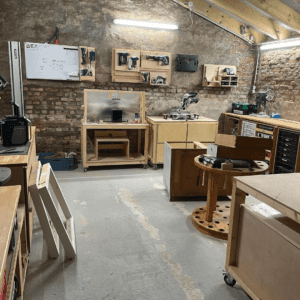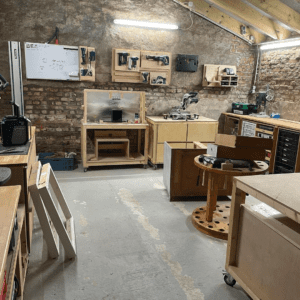The key to a productive home workshop is planning. In their garage or basement, more and more people are setting up carpentry or model engineering shops.
Make sure your environment is dry before beginning. Your garage’s roof, windows, or door may need to be fixed. In order to prevent dampness, rust, and decay from occurring, you must waterproof your basement if you intend to use it.
The next thing you should do is set up a water and electrical supply. If you want to maintain your job clean, you need to have a place where you can wash your hands. It’s crucial to have a power source that can power your machine tools. These devices will be hooked in permanently. Additionally, you will require a lot of switched electrical outlets that are three feet off the ground. These are going to be plug-in tools.
There will need to be more lights installed. For most home workshops, three fluorescent fittings will be plenty. The glare-free ones are preferable, but four of these might suit. Make sure they are positioned over your lathe, drill, and saw.
You must think about where to put your machine tools. These must face a wall and be set back from the door. This lessens the likelihood that someone will be wounded when strolling around the back. Installing a dust extraction system is necessary, particularly for wood and plastic manufacturing. By doing this, you can gather any possibly dangerous sawdust from your machining regions and dispose of it.
The final decisions involve choosing your workbench and tools.
The finest option is a few conventional woodworking benches made of solid wood. These are securely constructed to last for years, and they will.
For amateur model makers and woodworking firms, a lathe is a need.
It is simply a tool for reshaping finished materials with square cross sections made of wood, metal, or plastic into circular cross sections. By spinning the material while holding it between two plates, this is accomplished. Someone cuts off some of the material holding a sharp tool against it as it spins. Lathes are used to make round legs for tables and chairs.
Lathes are available in a variety of specifications and are built for various levels of application. It is obvious that the home model maker will require a considerably lower-spec lathe than a lumber company that makes tables. The output of the motor, the separation between centers (the clamping plates), supports, and chuck size is some of the specifications that vary.
One starting out in either a home model building or a home-based business should certainly give this option some thought first. Buying used lathes is not too difficult.
The majority of woodworkers now favor band saws over other power saws. It rotates on two or three wheels and has a long blade made of steel. The band is available in a variety of widths, and irregular shapes and scrollwork can be cut with a narrow band saw blade.
Large band saws are used in timber mills to rip lumber; they are preferred to circular saws for ripping since they produce less waste.
Large band saws called resaws are designed for a small kerf and low waste. The blade is typically between two and three inches broad. They are generally employed to manufacture veneer cutting wood along its thickness.
A variety of band saws are available for home woodworkers to utilise in their garage or basement workshop.
Visit DIY Home Wood Plans for more information.


